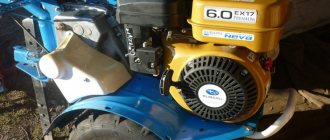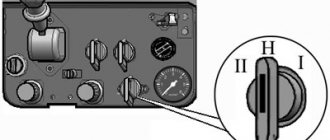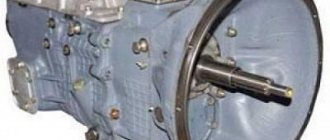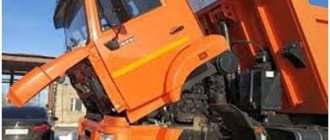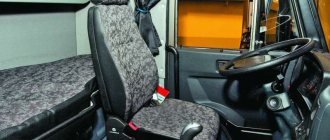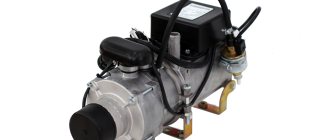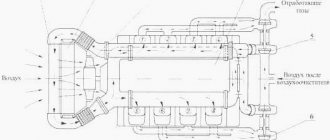One of the ways to increase the power of a diesel engine is a gas turbine supercharging system. Its main element is the turbocharger. It is installed on the discharge manifold and is driven by the energy of the exhaust gases. The use of a turbine on KamAZ gives an increase in engine power of about 25%. These trucks use two-row V-shaped power units. Therefore, 2 compressors are installed - each on its own unit.
Constantly increasing requirements for environmental safety lead to the fact that manufacturers are forced to improve the designs of engines and turbocharging systems. Therefore, when choosing a compressor and installing it yourself, you need to take into account the model of the truck and the brand of the power unit.
How does it work
The turbine is installed on KamAZ diesel engines to increase the power of the unit. The operating principle of a turbocharger and a turbocharger are different, but both serve to supply compressed air to the cylinders, thereby increasing the amount of fuel burned. As a result, fuel consumption becomes more economical and power increases.
The turbocharger is driven by the engine itself, causing some power to be lost. The operation of the turbocharger, which is installed on all modifications of the KamAZ 740 engine, will be more productive.
The turbocharger receives energy from the exhaust gases, which first enter the turbine and are then sent to the compressor at high speed. The latter, in turn, is driven by a turbine, which transmits the energy of the exhaust gases to it.
In the compressor, the air accelerates to an even higher speed and enters the diffuser, in which it is compressed. Such a device will work better with cooling: on some models (for Euro III engines) a charge air cooling system is installed. When cooled, the air is compressed even more, which allows more air to be delivered to the cylinder with the same volume.
Main symptoms of a malfunction
If this mechanism begins to malfunction, you will immediately feel it. First of all, a turbine malfunction will be reflected in the driving performance of the car. Thus, the acceleration dynamics will significantly disappear. It will be difficult for the machine to reach the desired speed, especially when going uphill or when loading. The engine will also have a harder time revving up. In fact, it will turn into an ordinary “aspirated” car. And as you know, on turbocharged cars the tachometer needle significantly “comes to life” after a certain rpm range (2 thousand or more, depending on the type of engine). If the compressor is faulty, it will rise as slowly as at the beginning.
What turbines are installed on KamAZ
Today the most common is the KamAZ Euro-2 turbine. It is equipped with 4 brands of engines:
- 740.31-240;
- 740.30-260;
- 740.50-360;
- 740.51-320.
Compressors are produced by 3 Russian enterprises. The KamAZ association and OJSC Turbotekhnika produce TKR-7 turbine units. The characteristics of the product, made according to a two-console design, allow them to be used on Euro-1 engines. A Belarusian enterprise in the city of Borisov produces an analogue of the TKR-7 turbine. The German concern Borg Warner Turbo Systems produces high-quality products - with higher characteristics than Russian and Belarusian ones.
Vehicles equipped with Cummis power units are equipped with their own compressors. You need to know that in addition to these engines, the others are equipped with paired turbines: right and left. KamAZ Euro-3 trucks are most often equipped with units from the German brand Schwitzer.
For Euro-1 engines, CZ turbochargers are suitable; the manufacturer is a company from the Czech Republic, licensed by the German Schwitzer. This turbocharger is applicable to the 740.11 and 740.13 engines and can be replaced with the Russian-made TKR-7N-1.
Turbines from European suppliers are more expensive, but it is believed that their quality is better. Domestic models are more affordable, and in the event of a breakdown, the necessary spare parts are easier to find.
You can find prices and detailed technical specifications in the catalogs on the websites of companies selling turbochargers from different manufacturers.
Device
The turbocharger, which is part of the gas turbine charging system, allows compressed and cooled air to be supplied to the engine cylinders, which increases the power of the unit by burning more fuel at a constant volume.
The engine and turbocharger are directly connected, so certain engine models have their own turbocharger modifications. The turbine is located directly on the engine.
For two-row engine modifications, it is recommended to install two turbines. Their size is relatively small: the diameter of the compressor and turbine housing is about 22 cm, and their weight is no more than 10 kg.
What is a KAMAZ turbocharger? Its components are a compressor and a gas turbine, which is a housing with an impeller (turbine wheel + rotor). The compressor design includes a wheel, blades and a diffuser with inlet and outlet manifolds. Between the wheels of the compressor and the turbine there is a shaft that transmits energy to the compressor, which subsequently directs energy from the exhaust gases from the turbine to the engine cylinders.
Prevention
In order not to wonder how to check the turbine, you need to know preventive measures. A few simple tips noted below will significantly extend the life of your element:
- Follow the instructions for replacing the air filter. In half of the cases, increased oil consumption and other problems with the turbine arise precisely because of a dirty filter. And if the thrust simply disappears on naturally aspirated engines, then the entire mechanism will be overloaded (namely the compressor, due to the difference in pressure in the inlet and outlet).
- Keep an eye on the oil level. Even short-term “starvation” is very harmful for the engine and turbine. Fill only with oil recommended by the manufacturer. Often breakdowns occur due to the use of counterfeit products. As for the replacement regulations, it is slightly different from conventional naturally aspirated engines. On turbocharged engines, the oil is changed every 7 thousand kilometers.
- Control the amount of boost. This is especially true for those who install a non-standard turbine on gasoline engines. This parameter must be within one bar. Remember that with each increase in “boost” the engine endures enormous loads.
- Before turning off the engine after a trip, let it idle for 1-2 minutes. This will eliminate carbon deposits that harm turbine bearings.
Turbine rotor
The turbocharger rotor consists of a turbine wheel and shaft, as well as a compressor wheel. The rotor rotates in bearings made of bronze. Bearings are used to balance the rotation of the rotor and wheel, making possible a thrust bearing that corrects deviation from the axis of rotation.
The turbine size is 23 cm in diameter, weight is 7-10 kg. All parts of the turbocharger are made of heat-resistant materials.
The air entering the rotor spins and enters the compressor at high speed. Rotor speed – 75 thousand/min.
How to check
A turbocharger malfunction is characterized by the presence of one or more distinctive features:
- increased oil consumption;
- uncharacteristic sound of the operating unit;
- drop in power plant power;
- the appearance of gray or blue smoke from the exhaust pipe.
You can check the turbine without removing it from its original location. Primary diagnostics of the unit’s performance includes:
- inspection of turbine and compressor blades;
- checking the condition of the pipes;
- monitoring the presence of axial and radial play.
To check the condition of the blades, it is necessary to disconnect the exhaust pipe of the turbine and the pressure pipe of the compressor. The entry of even small solid particles into the working cavities leads to the formation of scuffs and chips on the body of the blades. At high rotation speeds (70-90 thousand rpm), this leads to imbalance of the turbine unit, uneven load on the bearings, vibration and, as a result, a drop in speed. Turbine malfunctions worsen boost parameters and reduce engine thrust.
The pipes must be free of oil. In some cases, oil fogging may be observed at the outlet of the compressor, but the pressure pipe remains dry. Oily pipes and increased oil consumption can be caused by both turbine and engine malfunctions. Correctly determining the location of the defect will allow you to make the right decision to eliminate it.
The presence of play in the radial and axial directions is fraught with the blades touching the walls of the cochlea. This can lead to complete destruction of the unit. Shift of the rotor in the axial direction is unacceptable. A play in the diametrical plane of no more than 1 mm is possible. If the rotor movement is greater than normal, then the turbine unit must be dismantled for repair or replacement.
If the diagnostic results failed to detect a malfunction, then it is necessary to check the tightness of the exhaust tract for the turbine and the pressure tract for the compressor. A drop in vehicle power may be due to poor adjustment or malfunction of the fuel equipment. The condition of the air filter has a great influence on the boost parameters.
Smoke color and exhaust smell
The appearance of smoke in the exhaust system cannot be ignored; you should take a closer look at it. The process is often accompanied by an unpleasant chemical odor, which is clearly audible when moving.
Presence of black smoke
This indicates combustion of the combustible mixture in the turbine. The defect may be caused by a lack of oxygen in the fuel system. You should check:
- all pipes and their connections for leaks;
- electronic control unit;
- air filters;
- quality of operation of the entire fuel system;
- motor.
Particular attention should be paid to filters; the most common cause of lack of air in the fuel system is a dirty filter element.
Blue smoke
This indicates that oil is entering the combustion chamber. The cause may be a leak, which lies in a problem with the turbocharger or engine. In this case, it is necessary to inspect and check all connections.
White smoke
The main reason for this defect is a clogged oil drain line. It needs to be replaced or repaired.
Repair
Self-repair of KamAZ turbines is possible if spare parts are available. In most cases, impellers and bearings fail. It is impossible to restore, let alone balance, the unit shaft in a garage without special machines. In this case, the turbine can only be repaired in a specialized workshop.
Repair of a turbine unit involves:
- disassembly;
- identification of a damaged element or node;
- replacement of parts with functional ones;
- balancing the shaft with impellers;
- assembly of the unit;
- re-balancing of the assembled turbine.
It is impossible to qualitatively eliminate a malfunction without replacing defective elements. Operating experience shows that a breakdown repaired in a garage will soon return, only with more severe consequences.
In most cases, turbine defects are associated with failure of the angular contact bearing.
This can happen either due to non-compliance with the operating rules of turbocharged engines (engine stopping without idling) or due to a malfunction in the lubrication system.
If the filters are not functioning well and there are foreign impurities in the oil, the gap between the oil discharge screen and the seal disk decreases, which leads to a deterioration in fluid circulation in the system. This entails the breakdown of the oil wedge and, as a consequence, melting of the bearing. Therefore, when dismantling the turbine, the turbocharger lubrication system must be checked.
Signs of turbocharger failure
As mentioned above, a bluish-gray exhaust indicates the combustion of oil in the engine cylinders, which got there from the turbocharger or engine. Black indicates air leaks, and white indicates a blockage in the oil line. The appearance of a whistle may indicate an air leak at the junction of the compressor and the engine. A grinding sound indicates abnormal friction of parts and structural elements.
In case of periodic shutdown or complete failure of the turbine, all its parts and components should be checked. The bulk of all turbocharger breakdowns are due to three reasons. About them below.
Insufficient oil pressure
It can occur due to a leak or when the oil hose is pinched, or due to improper connection to the turbine. Leads to rapid wear of the rings, shaft journal, poor lubrication and a sharp increase in temperature on the radial bearings of the turbocharger. They will need to be replaced with new ones.
Contaminated oil
It can occur due to untimely replacement of lubricant or oil filters, when water or fuel gets into the oil, as well as when using low-quality lubricants. Leads to premature wear of bearings, clogging of oil pipeline channels, and damage to the axle.
Failed elements must be replaced with new ones.
Foreign object inside turbocharger
May damage or break compressor wheel blades, resulting in reduced air pressure; turbine wheel blades; rotor. In this case, the compressor will need to replace the filter and check the intake tract for leaks. On the turbine side, the shaft needs to be replaced and the intake manifold checked.
How to disassemble it yourself
If a turbocharger malfunctions, it needs to be repaired, but first of all it must be removed and disassembled. It is not difficult to dismantle and disassemble it yourself, because the design of the turbine is simple. First, all pipelines are disconnected, then the compressor and turbine: removing the latter requires some effort.
After dismantling has been carried out, you can begin to disassemble the device itself:
- Remove the compressor wheel using a special pliers remover. It is important to know that the compressor shaft has a left-hand thread. Remove the seals from the rotor and remove the thrust bearing.
- Loosen the retaining ring of the end part liners and remove them.
When disassembling the turbocharger, it is necessary to clean the seals, cartridge and other elements.
The video shows the disassembly process in full:
Troubleshooting
To make sure that the element is in good condition, you can troubleshoot it. How to check the turbine? To do this, disconnect the pipe that goes to the air filter and inspect the turbine blades. They must be without nicks or nicks, with the correct shape (not bent). If the impeller is damaged, the compressor must be replaced or repaired.
If your car uses an air cooler (intercooler), it also needs to be inspected. There are no oil leaks inside it. Otherwise, the compressor needs repair.
How to install
Some owners of trucks with non-turbocharged engines independently install units to increase engine power. Installing a turbine on a simple KamAZ truck involves making a foundation, because The design does not provide for such a place. Most often, one unit is installed on both blocks. In most cases, turbochargers of Czech or German production are used.
Experts believe that before installing a turbocharger on a KamAZ-740 (simple), it is necessary to change the crankshaft and piston group to reinforced ones. Otherwise, problems will arise with the engine, and then more parts will have to be replaced.
Such units are also installed on turbocharged engines: one instead of two. This is cheaper, and the likelihood of failure is halved. This installation can be carried out either independently or by contacting a service. A specialized enterprise will not only carry out the work professionally, but will also provide a guarantee for its completion. Many car owners believe that it is much easier to install an engine of suitable power than to adapt a turbine to it, and carry out the settings by trial and error.
Before installation, you need to remove the transport plugs and fill in 20-30 grams of engine oil. After this, you need to check how the rotor rotates.
You can install the turbocharger yourself:
- Install the “snails” directly onto the engine (the installation diagram for each model is individual, described in detail in the operating manual)
- After the turbocharger is installed on the engine, it is necessary to connect it to various systems
- Connect the exhaust manifold: it is important that small parts and debris do not get into it, otherwise the rotor may jam
- Connect the exhaust pipe
- Install air duct
- Provide oil supply
During installation, you will need various sealing materials (seals), fittings, bolts, nuts, washers, clamps, tubes (may be included in the kit). On the websites of spare parts stores you can find catalogs that describe all the parts needed to install a specific turbocharger model.
A welding machine is required to connect the exhaust manifold.
What is the difference between checking on a gasoline engine?
On gasoline cars, the imminent failure of the turbine can be determined by the same signs. Here the exhaust turns blue or white when the car accelerates. If there are air leaks in the injection channels or if the fuel system malfunctions, black smoke appears. A white exhaust with the smell of burnt oil will indicate a lubricant leak into the exhaust system. May be caused by increased end play, circlips not holding oil pressure. If oil gets into the exhaust system, soot will form on the hot turbine wheel, which will subsequently lead to an imbalance of the unit with subsequent destruction of the bearing housing.

